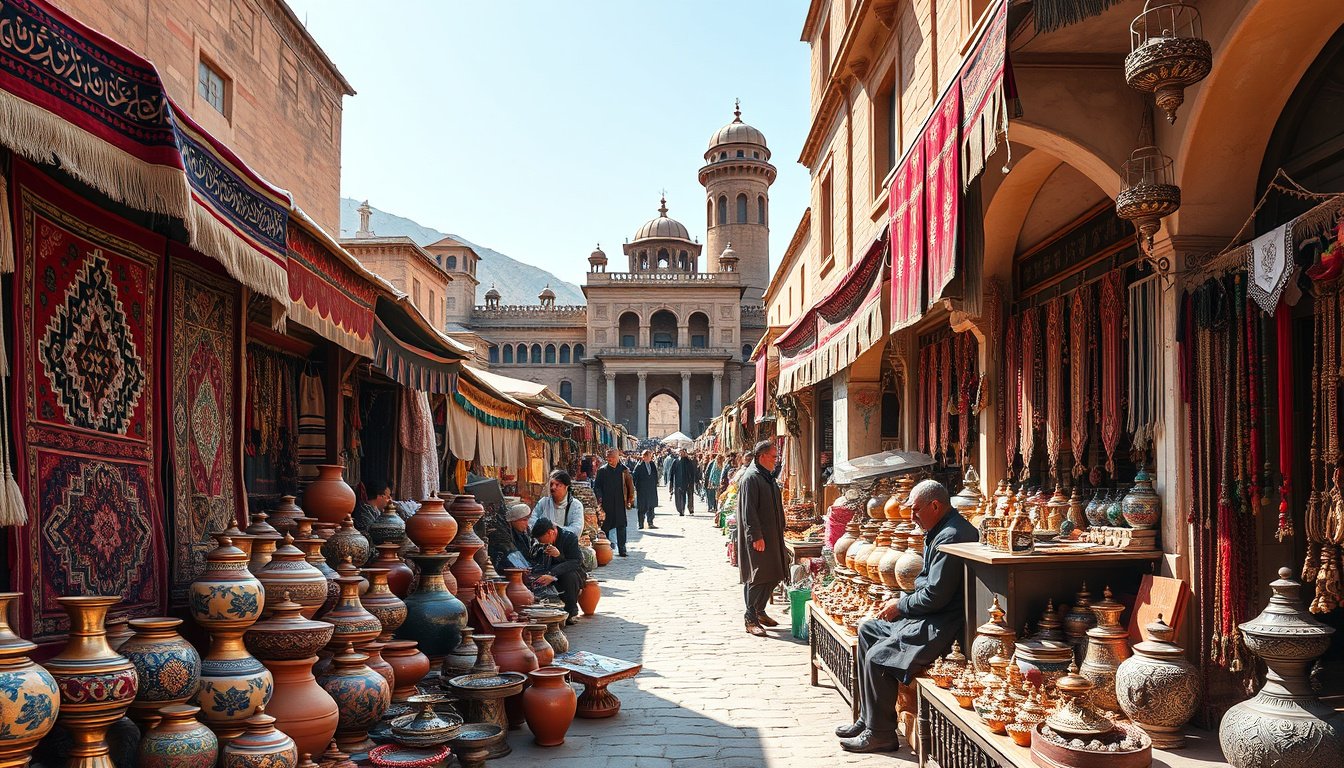
Dusty mountain light washes over mud-brick minarets, the scent of cardamom tea drifts through Kabul’s bazaars, and the blue of Badakhshan lapis seems to hold the sky. Afghanistan’s markets are layered with color, texture and story — from Herat’s rugs to Bamiyan’s carved wood — and each object feels like a small piece of landscape and history.
Whether you’re drawn to hand-spun wool, gemstone glints, or spice-scented jars, Afghan souvenirs capture craftsmanship passed down through generations. Here’s what to buy in Afghanistan to bring a piece of its rich heritage home with you.
-
Hand-knotted Afghan rug
Why pick this up: A rug is a living map of village identity — patterns, dyes and knots that speak of family looms and nomadic routes. It’s one of the most enduring keepsakes of Afghan artistry.
What to look for: Natural wool and vegetable dyes, even knotting (high knot-counts indicate finer work), and regional motifs (Baluch, Khal Mohammadi, Herati). Ask about provenance and whether it’s hand-knotted rather than machine-made.
Price bracket (2025): ؋5,000–150,000 (small prayer rugs to large room-sized pieces)
Where to find it: Kabul’s bazaars (including Chicken Street), Mazar-i-Sharif markets, Herat carpet cooperatives and workshops around Kandahar and Kunduz. -
Pashmina shawl (Afghan cashmere)
Why pick this up: Sumptuously soft and light, Afghan pashmina makes for an elegant souvenir that’s both practical and luxurious — perfect for cool nights in the mountains or city winters.
What to look for: Pure cashmere (feel the softness), tightly woven fabric, even fringe and natural undyed or subtly hand-dyed shades. Beware of blends labeled as pashmina that are mostly synthetic.
Price bracket (2025): ؋4,000–30,000
Where to find it: Specialist textile stalls in Kabul, small shops in Herat and bazaars in Mazar-i-Sharif. -
Lapis lazuli jewelry
Why pick this up: Afghanistan’s Badakhshan mines have produced the world’s finest lapis for millennia — deep ultramarine stones with golden flecks feel like holding a shard of the sky.
What to look for: Intense, uniform blue with tiny pyrite specks (not large white calcite veins), secure settings, and a certificate or clear sourcing from Badakhshan if possible.
Price bracket (2025): ؋1,000–25,000 (pendants and beads to more substantial pieces)
Where to find it: Gem and jewelry shops in Kabul and Herat; sellers from Badakhshan in regional markets. -
Suzani embroidery
Why pick this up: Vibrant circular and floral motifs stitched in silk or cotton — suzanis are heirloom textiles used as wall hangings, bed covers or prayer cloths, full of Central Asian pattern and color.
What to look for: Hand-stitched, strong colors (silk thread if possible), traditional motifs (sunbursts, pomegranates) and even stitching on the reverse side.
Price bracket (2025): ؋2,000–40,000 (cushion covers to large wall pieces)
Where to find it: Women’s cooperatives and textile shops in Herat, Kabul craft markets and specialty galleries. -
Herat saffron
Why pick this up: Afghanistan’s Herat saffron is intensely aromatic and prized for its floral, honeyed notes — a small jar will transform rice or tea and is a fragrant reminder of the region.
What to look for: Deep red threads (stigmas), strong aroma, and buy sealed jars or from a reputable vendor; ask for weight (saffron is sold by gram).
Price bracket (2025): ؋1,200–6,000 per gram
Where to find it: Spice stalls in Herat, Kabul’s spice markets and cooperatives that sell directly from Herat farms. -
Dried fruits and nuts
Why pick this up: Afghanistan’s climate yields some of the best pistachios, raisins (kishmish), dried apricots and mulberries — dense, flavorful and perfect as edible souvenirs.
What to look for: Fresh aroma, plumpness (not overly dry), and transparent weighing/scales; keep in airtight tins for travel.
Price bracket (2025): ؋200–1,500 per kilogram
Where to find it: Fruit markets in Kandahar (pomegranates), Balkh and Mazar-i-Sharif, plus spice stalls throughout Kabul. -
Hand-hammered copperware and teapots
Why pick this up: Beautifully hammered copper and brass trays, teapots and samovars are central to Afghan tea rituals and make striking tabletop pieces back home.
What to look for: Solid construction, even hammer marks, tight spouts and handles, and a tasteful patina or polished finish; tin-lined interiors for cookware are a plus.
Price bracket (2025): ؋800–12,000
Where to find it: Metalwork shops in Kabul, Herat and bazaars in Kandahar; look for established workshops where pieces are made locally. -
Pakol hat
Why pick this up: The soft wool pakol is a cozy, iconic hat from the highlands — practical, packable and full of regional character, it’s a wearable memory of Afghan mountains.
What to look for: Thick, locally spun wool, sturdy stitching and a good fit; traditional neutral colors or dyed variations for a modern touch.
Price bracket (2025): ؋200–1,500
Where to find it: Street stalls and textile shops in Kabul, markets in Paktia and the eastern highlands. -
Miniature paintings and Persian calligraphy
Why pick this up: Delicate miniature scenes and hand-lettered calligraphy continue a centuries-old artistic tradition — framed or rolled, these pieces are intimate tokens of Afghan art.
What to look for: Hand-painted detail, signed or attributed artists when possible, quality paper or card, and clear framing for transport.
Price bracket (2025): ؋500–40,000 (prints to original miniatures)
Where to find it: Art galleries and studios in Herat (noted for its painting tradition), Kabul art shops and cultural centers. -
Hand-carved wooden boxes and inlay work
Why pick this up: Small carved or inlaid boxes are perfect for jewelry, keepsakes or spices — they often feature geometric inlay, floral carving or lacquer work unique to regional woodworkers.
What to look for: Tight joints, smooth interior finishes, intricate inlay or carving and a secure latch; woods like walnut or local hardwoods give durability.
Price bracket (2025): ؋400–12,000
Where to find it: Woodwork stalls in Bamiyan and Kabul, artisan workshops around Herat and regional craft markets.
Tip: Shop respectfully, avoid anything that looks like an archaeological artifact, get receipts and provenance for high-value pieces (lapis, rugs), and keep customs rules in mind when buying Afghan souvenirs — receipts help at the airport. ✈️

